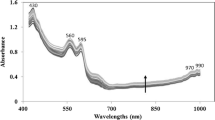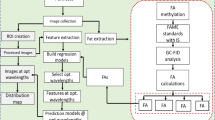Abstract
The effectiveness of hyperspectral imaging (400–1000 nm) was proved as a nondestructive method to detect, classify, and quantify plant- and animal-based adulterants in minced beef and pork. Machine learning techniques were implemented to build classification and prediction models. Samples were first classified into adulterated (1 class) or pure (5 classes). The type of adulterant (6 classes) was then evaluated. Finally, the level of each adulterant was estimated using partial least squares regression. The optimal classification models based on selected wavelengths of test set yielded classification rates of 75–100% and 100% for pure and adulterated samples, respectively. Whereas, the rates were 83–100% depending on adulterant type. Prediction models for adulterant level yielded correlation coefficient, r, and ratio of performance to prediction, RPD, of 0.69(1.41) for beef adulterated with pork and textured vegetable protein (TVP), and 0.93(2.82) for beef adulterated with TVP. Improvement in results may be achieved with larger sample size.






Similar content being viewed by others
References
Alamprese C, Casale M, Sinelli N, Lanteri S, Casiraghi E (2013) Detection of minced beef adulteration with Turkey meat by UV–vis, NIR and MIR spectroscopy. LWT- Food Sci Technol 53(1):225–232
American Meat Science Association (AMSA) (2012) Meat color measurement guidelines: AMSA. American Meat Science Association
Boyacı IH, Temiz HT, Uysal RS, Velioğlu HM, Yadegari RJ, Rishkan MM (2014) A novel method for discrimination of beef and horsemeat using Raman spectroscopy. Food Chem 148:37–41
Boysworth MK, Booksh KS (2001) Aspects of multivariate calibration applied to near-infrared spectroscopy. Pract Spec Series 27:209–240
Brehmer H, Schleicher S, Borowski U (1999) Determination of soya protein, pea protein and gluten in frankfurter-type sausages by means of an enzyme-linked-immunosorbent-assay (ELISA). Fleischwirtschaft (German)
Criado M, Castro-Rubio F, García-Ruiz C, García MC, Marina ML (2005) Detection and quantitation of additions of soybean proteins in cured-meat products by perfusion reversed-phase high-performance liquid chromatography. J Sep Sci 28(9–10):987–995
Dai Q, Cheng JH, Sun DW, Pu H, Zeng XA, Xiong Z (2015) Potential of visible/near-infrared hyperspectral imaging for rapid detection of freshness in unfrozen and frozen prawns. J Food Eng 149:97–104
de Jong SD (1993) PLS fits closer than PCR. J Chemom 7(6):551–557
Ding HB, Xu RJ (2000) Near-infrared spectroscopic technique for detection of beef hamburger adulteration. J Agric Food Chem 48(6):2193–2198
Duda RO, Hart PE, Stork DG (2012) Pattern classification. John Wiley & Sons
Ellis DI, Broadhurst D, Clarke SJ, Goodacre R (2005) Rapid identification of closely related muscle foods by vibrational spectroscopy and machine learning. Analyst 130(12):1648–1654
Fletcher T (2009) Support vector machines explained. Tutorial paper. University College London, London
Heinz G, Hautzinger P (2007) Meat processing technology for small to medium scale producers. FAO. Pp 3
Johnson R (2014) Food fraud and economically motivated adulteration of food and food ingredients. Congressional Research Service
Kamruzzaman M, ElMasry G, Sun DW, Allen P (2012) Prediction of some quality attributes of lamb meat using near-infrared hyperspectral imaging and multivariate analysis. Anal Chim Acta 714:57–67
Kamruzzaman M, Makino Y, Oshita S, Liu S (2015) Assessment of visible near-infrared hyperspectral imaging as a tool for detection of horsemeat adulteration in minced beef. Food Bioprocess Technol 8(5):1054–1062
Kerry JP, Kerry JF, Ledward D (Eds.) (2002) Meat processing: improving quality. Elsevier
Kerth CR (2013) The science of meat quality. John Wiley & Sons
López MCG, Alegre, MLM (2009) Detection of adulterations: addition of foreign proteins. In Handbook of processed meats and poultry analysis (pp. 155). CRC Press Boca Raton
Mancini RA, Hunt MC (2005) Current research in meat color. Meat Sci 71(1):100–121
Mao KZ (2004) Orthogonal forward selection and backward elimination algorithms for feature subset selection. IEEE Trans Syst Man Cybern B Cybern 34(1):629–634
Millar SJ, Moss BW, Stevenson MH (1996) Some observations on the absorption spectra of various myoglobin derivatives found in meat. Meat Sci 42(3):277–288
Morsy N, Sun DW (2013) Robust linear and non-linear models of NIR spectroscopy for detection and quantification of adulterants in fresh and frozen-thawed minced beef. Meat Sci 93(2):292–302
North American Meat Institute (NAMI) (2015) The amazing meat & poultry supply: a snapshot. Available at: http://www.themarketworks.org/sites/default/files/uploads/The-Amazing-Meat-and-Poultry-Supply.pdf/ Accessed at: August 16, 2018
Pegau WS, Gray D, Zaneveld JRV (1997) Absorption and attenuation of visible and near-infrared light in water: dependence on temperature and salinity. Appl Opt 36(24):6035–6046
Premanandh J (2013) Horse meat scandal: a wake-up call for regulatory authorities. Food Control 34(2):568–569
PWC, SSAFE (2015) Food fraud vulnerability assessment. Available at: https://www.pwc.nl/en/industries/agrifood/ssafe-food-fraud-tool.html. Accessed 16 Aug 2018
Rady A, Adedeji A (2018) Assessing different processed meats for adulterants using visible-near-infrared spectroscopy. Meat Sci 136:59–67
Rady A, Ekramirad N, Adedeji AA, Li M, Alimardani R (2017) Hyperspectral imaging for detection of codling moth infestation in GoldRush apples. Postharvest Biol Technol 129:37–44
Ropodi AI, Pavlidis DE, Mohareb FE, Panagou Z, Nychas GJ (2015) Multispectral image analysis approach to detect adulteration of beef and pork in raw meats. Food Res Int 67:12–18
Somol P, Novovicová, J, Pudil P (2010) Efficient feature subset selection and subset size optimization. In Pattern recognition recent advances. InTech
Spink J, Moyer DC (2011) Defining the public health threat of food fraud. J Food Sci 76:157–163
USDA-ERS (2016) United State Department of Agriculture – Economic Research Service. Beef Industry, 2016. http://www.ers.usda.gov/topics/animal-products/cattle-beef/statistics-information.aspx/ Accessed 16 Aug 2018
USDA-ERS (2018) United State Department of Agriculture – Economic Research Service. Food and Beverage Manufacturing, 2018. https://www.ers.usda.gov/topics/food-markets-prices/processing-marketing/manufacturing.aspx /Accessed 16 Aug 2018
Varmuza K, Filzmoser P (2016) Introduction to multivariate statistical analysis in chemometrics. CRC Press
Warriss PD (2000) Post-mortem changes in muscle and its conversion into meat. Meat Science: An Introductory Text, 93–105
Wise BM, Gallagher N, Bro R, Shaver J, Windig W, Koch RS (2007) PLS Toolbox 4.0. Eigenvector Research Incorporated 3905
Xiong Z, Sun DW, Dai Q, Han Z, Zeng XA, Wang L (2015) Application of visible hyperspectral imaging for prediction of springiness of fresh chicken meat. Food Anal Methods 8(2):380–391
Zongker D, Jain A (1996) Algorithms for feature selection: an evaluation. In proceedings of 13th international conference on pattern recognition (Vol. 2, pp. 18-22). IEEE
Acknowledgments
The information reported in this paper (18-05-081) is a project of the Kentucky Agricultural Experiment Station and it is published with the approval of the Director.
Funding
This work was supported by the National Institute of Food and Agriculture, US Department of Agriculture, Hatch-Multistate project no. 1007893.
Author information
Authors and Affiliations
Corresponding author
Ethics declarations
This study was funded by the National Institute of Food and Agriculture, US Department of Agriculture, Hatch-Multistate project (no. 1007893).
Conflict of Interest
Akinbode Adedeji declares that he has no conflict of interest. Ahmed Rady declares that he has no conflict of interest.
Ethical Approval
This article does not contain any studies with human participants or animals performed by any of the authors.
Informed Consent
Not applicable.
Additional information
Publisher’s Note
Springer Nature remains neutral with regard to jurisdictional claims in published maps and institutional affiliations.
Rights and permissions
About this article
Cite this article
Rady, A., Adedeji, A.A. Application of Hyperspectral Imaging and Machine Learning Methods to Detect and Quantify Adulterants in Minced Meats. Food Anal. Methods 13, 970–981 (2020). https://doi.org/10.1007/s12161-020-01719-1
Received:
Accepted:
Published:
Issue Date:
DOI: https://doi.org/10.1007/s12161-020-01719-1




